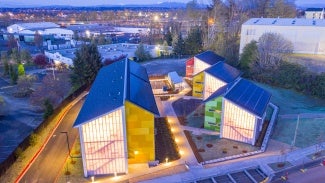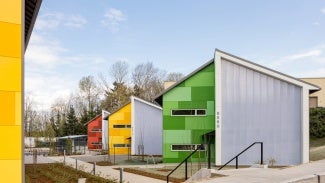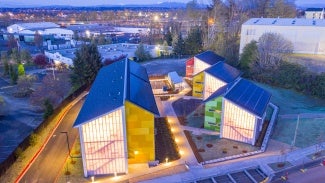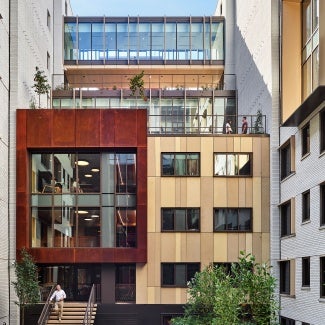Argyle Gardens
The award-winning housing design of Argyle Gardens in Portland, Ore. represents a crucial step forward in the city’s affordable housing with the first implementation of a modular, low-income single-adult housing model.

Project highlights: Argyle Gardens
- Architect: Holst Architecture
- Owner: Transition Projects
- Location: Portland, Ore.
- Category: Specialized Housing
- Project site: Brownfield
- Building program type(s): Residential — multifamily, 5 or more units
Argyle Gardens is the first implementation of a modular, low-income single-adult housing model developed by the design team and Transition Projects, an organization dedicated to providing life-changing assistance to Portland’s most vulnerable residents. The first modular housing project permitted by the city, this new community of 72 housing units in the Kenton neighborhood stands as a new co-housing model whose residents share community space and other support systems. It represents a crucial step forward in the effort to design, build, and maintain affordable housing across the nation.
As a development, Argyle Gardens comprises four different buildings, the largest of which contains 35 220-square-foot studio apartments as well as a community room, laundry facilities, and support services that make it a central hub for the community. The three separate cohousing buildings contain two units with six bedrooms, two bathrooms, and a large kitchen. Argyle Gardens opened at a pivotal moment in 2020, providing critical housing for formerly homeless and low-income Portlanders during the height of the COVID-19 pandemic.
The overarching design concept offers maximum impact for minimal cost. To that end, the buildings are formed by modular units that were constructed off-site and further enhanced by gabled roof trusses, shingled roofs, and durable cladding that obscure the modular components from the exterior. Each of them takes on a simple rectilinear form with a bold slice removed to reveal the color and light that passes through polycarbonate panels. This approach, supported by low-income tax credits from the state of Oregon, allowed the team to reduce development costs by 31% compared to typical affordable housing projects. Those savings are passed on to residents who pay as little as $300 monthly rent.
Existing vegetation and steep topography on the formerly industrial site challenged the team to arrange the buildings in a way that accommodated ADA access requirements, environmental considerations, and the large staging area required for modular construction. But the resulting calibration of the siting addresses those issues successfully while minimizing direct solar heat gain on the polycarbonate walls. The project also garnered an Earth Advantage Platinum Rating because of its numerous features that reduce its impact on the environment, including drought-resistant landscaping, LED fixtures, and a rooftop photovoltaic array.
From the outset, the design team engaged Kenton’s supportive and progressive community, which recognizes that the transformation of the site, once plagued by illegal dumping, has boosted the neighborhood’s vitality. With its efficient construction techniques and aesthetic typology, Argyle Gardens can be scaled up or down and easily adapted to suit a variety of locales, providing similar benefits for communities across the country.
Framework for Design Excellence measures
Was there a design charrette? Yes
Site area that supported vegetation (landscape or green roof) pre-development: 29%
Site area that supports vegetation post-development: 45%
Site area covered by native plants supporting native or migratory species and pollinators: 76%
Strategies used to promote Design for Ecosystems: Biodiversity, Dark skies, Habitat conservation, flora/fauna, Abatement of specific regional environmental concerns
Is potable water used for irrigation? Yes
Is potable water used for cooling? No
Is grey/blackwater reused on-site? No
Is rainwater collected on-site? No
Stormwater managed on-site: 100%
2030 Commitment baseline EUI: 49.5 kBtu/sf/yr
Predicted net EUI including on-site renewables: 29.7 kBtu/sf/yr
Reduction from the benchmark: 40%
Is the project all-electric? No
Level of air filters installed: Unknown
Was a “chemicals of concern” list used to inform material selection? Yes
Do greater than 90% of occupied spaces have a direct view to the outdoors? Yes
Were embodied carbon emissions estimated for this project? Yes
Estimated service life: 60 years
Floor area, if any, representing adapting existing buildings: 0%
Ability to survive without utility power: Partial back-up power
Which of the following risk assessment and resilience services were provided? Hazard identification, Hazard mitigation strategies above code
Has a post-occupancy evaluation been conducted? Yes
Building performance transparency steps taken:
Present the design, outcomes, and/or lessons learned to the office
Present the design, outcomes, and/or lessons learned to the profession
Present the design, outcomes, and/or lessons learned to the public
Publish post-occupancy data from the project
Publish lessons learned from design, construction, and/or occupancy
Project team & jury
Year of substantial project completion: 2020
Gross conditioned floor area: 24000 sq. ft.
Project team: Modular Design and Fabrication: Mods PDX
Construction Manager: Walsh Construction
Civil Engineer: KPFF
Structural Engineer: Allstructure
Catherine Baker, FAIA, Chair, Nowhere Collaborative, Chicago
John DeForest, AIA, DeForest Architects, Seattle
Brian Lane, FAIA, Koning Eizenberg, Santa Monica, Calif.
Amit Price Patel, AIA, DIALOG, Vancouver, British Columbia
Michael D. Robinson, AIA, Robi4 Architecture & Planning, San Diego
The Housing Award recognizes the best home design, showing the world how beauty, safety, sustainability, and comfort can come together.
The Housing Award recognizes the best home design, presented by the AIA Housing and Community Development Knowledge Community.













